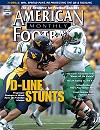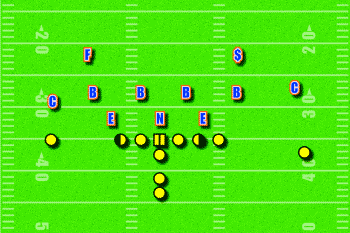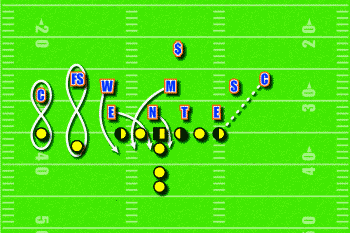AMERICAN FOOTBALL MONTHLY THE #1 RESOURCE FOR FOOTBALL COACHES
Article CategoriesAFM Magazine
|
Making an Offense One Dimensional: Strategies for Developing an Effective Run Deby: Mike Kuchar© More from this issue Stop the Run: It’s the number one objective for any defensive coordinator at any level; in fact it’s Defensive Football 101. You can’t play defense without first stopping the run. Rushing yardage is also the first statistical category offense will use to measure its performance. Teams that know how to control the clock by running the football win games. In fact, the two go hand in hand. If you look at successful teams from Pop Warner right up through the NFL – chances are they have two distinct advantages that make them win; they know how to run the ball, and they know how to stop the run. So, the apparent question is how do you effectively stop the run? We’ve talked to four defense coaches at different levels to get their philosophies and the staples that make good defense great and great defenses dominant- Ron Roberts, defensive coordinator at Delta State University (MS), Chuck Priore, head coach at Stony Brook, Joe Bernard, defensive coordinator at Duquesne and Jeff Devanney, head coach at Trinity College (CT) They broke it down into various components in shutting down the run game. Meshing Fronts and Coverages Whatever defensive scheme you play, mixing up fronts and coverage’s is key to shutting down a solid run game. By showing the offense different alignments, particularly on first down, you tend to draw them out of rhythm, often confusing the offensive lineman in their blocking assignments. Ron Roberts, the defensive coordinator at Delta State University, finds a way to mix-up his base 3-4, cover two scheme with a reduction 50, cover 3 defense. He’ll usually do this by showing his base package then before the snap, start rotating down a safety (bonus player) into the box to give added help against the run. The Sam linebacker will creep up on the line of scrimmage as will the Rob linebacker, moving the weak side end into the next adjacent gap. The two interior backers (Lou and Mike) bump over their alignments as well. Within a matter of seconds, Roberts’ scheme goes from a 3-4 to a 5-3, giving him the flexibility to play an eight man front with cover 3 behind it which is essential in stopping the run. “On definite run downs which to us are first and ten, second and medium to short (1-5) and third and short (1-3) we ask our free safety to buzz down on the quarterback’s cadence to linebacker depth and play in the box,” says Roberts. “He’s responsible for any cutback play away, and it also gives the two inside linebackers a chance to play fast and run downhill. Any type of isolation or power play directed at the inside backers will be ‘spilled’ out to the safety. If they get in trouble the safety is a fold player, basically free to make tackles. It’s a major cushion in the run game.” Roberts stresses that the key is to look complicated to the offense, but keep the teaching progression simple to your kids. “The Sam is still the strong linebacker whether he’s on the L.O.S. or not, and the Rob plays the same way. It’s not where they are when they break the huddle, but where they are after the snap. We just tell our guys they are responsible for a gap before the play and as long as they know what gap that is after the snap, we can go and make plays.” Outnumbering the offense at the point of attack Any defense can be tweaked and adjusted to fit any offense, but there are a few things that you must do as a defense to stop the run. The first is to outnumber the offense at the point of attack. On first down situations, you need to get more guys involved than the offense can block – it’s a numbers game. Since most teams will line up in regular personnel (two backs, one tight end) on first down, showing seven potential blockers, this usually involves the safeties to help with the run game. While most teams, like Delta State, adjust with bringing safeties down pre-snap Jeff Devanney at Trinity never tips his hand and plays almost everything from his 3-4 two-deep shell (See Diagram 1). “Our guys have really gotten good at reading run or pass by watching the EMLOS (end man on the line of scrimmage). We teach them the high hat/low hat principle where if they come out with their hat and pads low it is a run situation. If their hat is high, it usually is pass. But it gets more complicated in the play-action pass game. There you really have to check the line to see if they are slide protecting, instead of pulling someone because that is a dead giveaway for pass.”  Diagram 1. Trinity's 3-4 Devanney will go one step further by making sure his safeties understand their responsibilities in the run game. “When our safeties drop down into the box to help with the run game, they will always give the linebackers an ‘in call’ on run support, meaning they can play inside and are free to run. Our linebackers don’t even play gaps, we feel it’s too complicated. We just let them run and make plays. Everything gets bounced out to our safeties, they are the contain players in run situations. They’ll get most of the tackles.” Trinity will also run a period called an inside run period, where the entire defense will spend time “fitting” basic run plays such as the isolation, power, outside zone or trap. This is usually done at half speed at the beginning of practice so that players can see how the play develops in slower motion. Each player gets to their responsibility on the run. Since most teams run the same type of run plays, so it becomes second nature for defenses to defend it after seeing it plenty of times. Come with pressure The final component in playing good run defense is to mix and match zone and man pressures. While using the blitz is usually classified as a third and long situation, many teams will use it just as much, or if not more on running situations. Priore’s Stony Brook team is always on the move, blitzing 80 percent of the time out of their 3-4 set. In fact, he’ll use a zone blitz more on running situations than passing situations. “We don’t want to move a whole lot on passing downs like second or third and long. We want to get our defensive lineman up field right away, instead of wasting time slanting horizontally down the line of scrimmage. But it’s tremendous in the run game. From an offensive standpoint, all they really know is the snap count. They have no idea where you’re going after that. The toughest thing to do as an offensive line is to protect two gaps.” Priore believes the key is to keep offenses honest by mixing up different blitzes with different packages behind it. One of his favorites is his Bear Mack Blitz (See Diagram 2) when he brings six on the blitz, while playing cover three behind it. Priore uses it mainly on first downs in a definite run situation.  Diagram 2. Stony Brook's Bear mack Blitz Devanney, who was the defensive coordinator under Priore at Trinity last season- where the Bantams have won a national record 31 consecutive games, uses the same blitz combo with zone coverage underneath. “In all our zone pressures we have what we call a contain player and a crash blitzer. The crash player (the inside LB in this blitz) fits the inside hip of the defensive lineman where the contain player (the outside LB) works toward the outside shoulder of the deepest man in the backfield, forcing everything inside.” Devanney will also spend a fifteen minute time period in practice in what he calls a blitz circuit – makeshift trash cans will denote gaps created by offensive lineman and players will rifle through their assigned blitzes depending on the call. Joe Bernard uses more man pressure blitzes at Duquesne. He bases everything off of a 4-3, Cover 4 look with two high safeties. He’ll have a “four weak” or “four strong” package, where four blitzers will come off of the weak or strong side of the offense. His favorite call on run downs is the “Gangster Blitz” (See Diagram 3) which is a four weak blitz away from the tight end. The end and nose crash hard into their gaps while the Mike and Will linebackers come over the top. It’s his favorite call against twins when teams like to run away from the tight end – the free safety looks on the number two receiver.  Diagram 3. Dusquesne's Ganster Blitz According to the coaches we spoke with, the one thing you don’t want to do when implementing an aggressive run defense is over-coach yourself. Realistically, you want to keep it as simple as possible for your players and let them run and make plays. “My philosophy is to play straight up for as long as I can until we start getting hurt. Then I make adjustments,” says Bernard. As long as you get your players in the position to make plays, you’ve done your job as a coach – the rest is up to them. |
|
| HOME |
MAGAZINE |
SUBSCRIBE | ONLINE COLUMNISTS | COACHING VIDEOS |
Copyright 2024, AmericanFootballMonthly.com
All Rights Reserved




